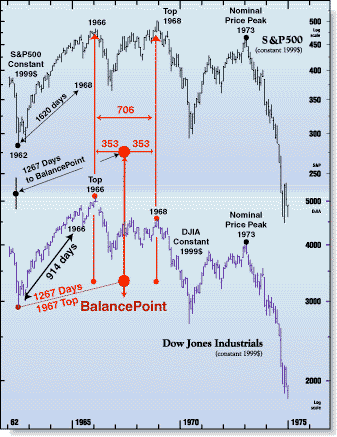NEW TECHNIQUES
Compound Pivots And Market Symmetry
by William T. Erman
Many traders see only simple symmetry such as a 20-week bottom-to-bottom move followed by another. Unfortunately, if indeed there is another 20-week cycle, it could very well turn out to be 18 weeks or 22 weeks instead of the anticipated 20. Ermanometry, which was introduced to STOCKS & COMMODITIES readers in February 1999, considers a 20-day window, the four-week spread, to be of little help in today's complex markets. Compound pivots are measured in days instead of weeks and take into account that markets are both very precise and spherical in character. They can be used to reveal market symmetry in increments of days and to illustrate the fact that successive identical moves in three-dimensional space may appear noncontiguous on the plane. Here, compound pivots and balance points, both tools used for decoding the hidden symmetry of the markets according to Ermanometry, are explained.

COMPOUND PIVOTSFIGURE 1: BALANCE POINT. A balance point in time is that day equidistant from the high (or low) of any two markets being measured. Here, there is a balance point in 1967, between the 1966 top in the DJIA and the 1968 top in the S&P 500.
Say you are planning a round-trip flight: Chicago to New York to Chicago. You want to find out how long it will take both ways. However, you do not know which of the three metropolitan New York?area airports will be your takeoff and landing points. Your plane could land at Kennedy, take off from LaGuardia, do either from Newark, or land and take off from the same airport.
Since flight time to the three airports will vary, and there's the possibility of different clearance and stacking times, you will have to consider all the alternatives and arrive at several different possible total times. When a market index takes off from a low, lands on a high, then heads down again, you can easily measure the elapsed time. When two indices are studied together and turn on different days -- land at different airports, if you will -- the elapsed time between each and every turning point must be measured.
It is not unusual for the DJIA and S&P 500 indices to record extreme, end-of-move, high or low intraday ticks on different days. If the indices have been rising or falling in concert, both are considered to be sharing the same market move. When the extremes are reached on different days, both days must be used for measurement purposes.
This set of pivotal days marks the beginning and end of a compound pivot (or a CompoundPivot in Ermanometry). This set is the outside pivot component of a compound pivot. It does not matter how many days separate the outside pivots, as long as both pivotal days are associated with the same market move. The outside pivots can span a period from as little as three days to more than 500. In addition to the two outside pivots, there is a third pivot component. This third is referred to as the balance point (BalancePoint in Ermanometry) because it is located precisely between the two outside pivots.
Figures 1 through 6 are some examples of compound pivots that illustrate the outside pivots and the balance points. Inflation-adjusted data shows the record high for the DJIA was made in 1966 and not exceeded until 1995. The move up to 1966 began in 1932; the same move in the S&P 500 did not top until 1968. Both indices participated in this macro move, and therefore, their respective 1966 and 1968 tops, although they are 706 days apart, are the outside pivots of a very large compound pivot. Figure 1 shows these tops and their related balance point.